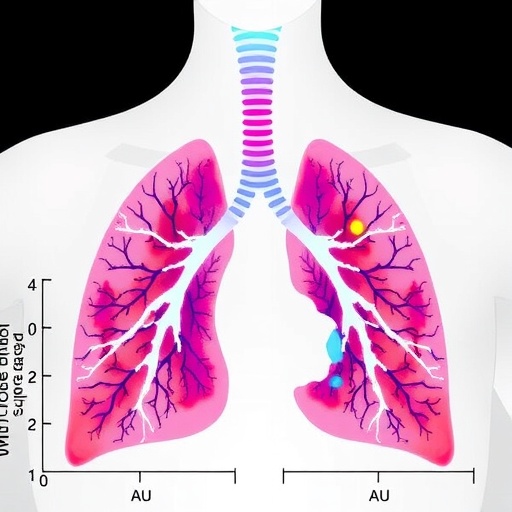In a groundbreaking study that could significantly alter the clinical management of papillary thyroid microcarcinoma (PTMC), researchers have developed a novel clinical-molecular prediction model aimed at detecting central lymph node metastasis (CLNM) in patients diagnosed with cN0 stage PTMC. This retrospective study, recently published in BMC Cancer, harnesses the power of molecular biomarkers alongside clinical features to create a predictive tool that may pave the way for more personalized and precise treatment strategies in thyroid cancer.
Papillary thyroid microcarcinoma, characterized by tumors not exceeding 1 cm in diameter, is generally considered a low-risk malignancy. However, whether to perform prophylactic central lymph node dissection (PLND) in patients clinically negative for lymph node involvement (cN0 stage) remains a contentious issue among surgeons and oncologists. The presence of occult metastasis in central lymph nodes is often missed by conventional imaging, yet has clinical significance in predicting recurrence and determining the extent of surgical intervention.
Recognizing the limitations of existing diagnostic tools, the study led by Wang et al. delves into the molecular underpinnings of PTMC associated with CLNM. Through comprehensive bioinformatics analysis of The Cancer Genome Atlas (TCGA) dataset, the researchers identified a set of differentially expressed genes (DEGs) that show potential as biomarkers for occult metastasis, thus bridging the gap between molecular oncology and surgical decision-making.
A robust methodological framework was employed where initial gene screening involved sophisticated statistical techniques such as Cox proportional hazards and least absolute shrinkage and selection operator (LASSO) regression analyses. These analyses distilled the complex data into a manageable panel of three prognostic genes: FN1, MT-1F, and TFF3. These genes not only demonstrated significant differential expression but also correlated strongly with disease-free survival outcomes at 5- and 10-year intervals, underscoring their clinical relevance.
In parallel, the study encompassed a cohort of 404 patients treated at the First Affiliated Hospital of Ningbo University in 2022. This sizeable sample was subdivided into derivation and validation subgroups for rigorous model testing. Quantitative real-time polymerase chain reaction (RT-qPCR) measured gene expression in tumor specimens, providing concrete molecular data that supplemented conventional clinical variables such as tumor size, calcification presence, multifocality, and extrathyroidal extension.
Interestingly, FN1 expression was markedly elevated in PTMC tissues compared to normal thyroid tissues, and this upregulation was significantly pronounced in patients exhibiting CLNM. Contrarily, MT-1F and TFF3 expressions were notably diminished in the same subgroup, revealing a nuanced regulatory pattern that may reflect the complex tumor microenvironment and metastatic mechanisms at play.
The clinical-molecular predictive model integrating these gene expressions with traditional predictors exhibited remarkable accuracy. Receiver operating characteristic (ROC) curve analyses showed area under the curve (AUC) values of 0.736 in the derivation cohort and an even more impressive 0.813 in the validation cohort. These findings underscore the model’s strong discriminatory capacity to identify occult metastasis with greater reliability than models relying solely on clinical parameters.
To ensure the model’s practical applicability, calibration curves and the Hosmer-Lemeshow goodness-of-fit test were utilized, confirming its reliability and consistency across patient populations. Furthermore, decision curve analysis (DCA) highlighted the tangible clinical benefit of employing this model, demonstrating improved decision-making potential that could reduce unnecessary surgeries and associated morbidities.
From a mechanistic standpoint, FN1 encodes fibronectin, a glycoprotein implicated in cell adhesion, migration, and extracellular matrix remodeling—processes central to cancer invasion and metastasis. The altered expression of metallothionein-1F (MT-1F), which plays roles in metal ion metabolism and oxidative stress responses, along with trefoil factor 3 (TFF3), known for its role in epithelial repair and cancer progression, collectively present a molecular signature intensely intertwined with metastatic behavior.
This study is particularly timely as the medical community increasingly embraces precision oncology, where molecular insights inform personalized treatments. By providing a validated model that merges molecular biology with clinical assessment, the research presents a framework that may refine surgical strategies in PTMC, avoiding overtreatment while ensuring timely intervention for those at higher risk.
Beyond its immediate clinical utility, this research may inspire further exploration into the molecular drivers of lymphatic spread in thyroid cancer, unlocking novel therapeutic targets. It also illustrates the expanding role of bioinformatics and high-throughput data analytics in transforming raw genetic information into actionable clinical tools.
While the findings are promising, the authors acknowledge that prospective studies and multi-center validations are necessary to ascertain the universality of the model across diverse populations and clinical settings. They also recognize the importance of integrating emerging imaging modalities and exploring additional molecular candidates to enhance predictive power further.
In essence, this study marks a significant step towards a molecularly guided clinical paradigm in PTMC management. It underscores the potential of integrating gene expression profiling into routine diagnostics, facilitating personalized surgical planning and possibly improving long-term patient outcomes.
As the precision oncology landscape continues to evolve, such clinically grounded molecular models exemplify how translational research can bridge the divide between bench and bedside, ultimately driving the next generation of cancer care innovations.
The development of this clinical-molecular prediction model not only highlights the dynamic interplay between genetics and clinical presentation but also encourages a re-evaluation of current guidelines regarding lymph node dissection in PTMC. Surgeons may soon have at their disposal a reliable tool that selects patients most likely to benefit from prophylactic interventions, minimizing unnecessary procedures.
Moreover, the ethical implications of reducing overtreatment are profound, as patients face fewer surgical risks, reduced healthcare costs, and improved quality of life. Personalized treatment plans, guided by molecular markers, align with patient-centered care philosophies gaining traction worldwide.
In conclusion, the pioneering work by Wang and colleagues represents a significant leap forward in understanding and managing cN0 stage papillary thyroid microcarcinoma. By harnessing molecular insights alongside conventional clinical factors, their model promises to enhance prognostication and clinical decision-making, marking a new chapter in thyroid cancer management.
Subject of Research: Development of a clinical-molecular prediction model for central lymph node metastasis in cN0 stage papillary thyroid microcarcinoma.
Article Title: Development of a clinical-molecular prediction model for central lymph node metastasis in cN0 stage papillary thyroid microcarcinoma: a retrospective study.
Article References:
Wang, J., Fu, W., Luo, J. et al. Development of a clinical-molecular prediction model for central lymph node metastasis in cN0 stage papillary thyroid microcarcinoma: a retrospective study. BMC Cancer 25, 693 (2025). https://doi.org/10.1186/s12885-025-14112-0
Image Credits: Scienmag.com
DOI: https://doi.org/10.1186/s12885-025-14112-0
Tags: bioinformatics analysis in cancer researchcentral lymph node metastasis detectionclinical management of thyroid cancerdifferential gene expression in PTMCmolecular biomarkers in canceroccult metastasis in thyroid cancerpapillary thyroid microcarcinoma diagnosispersonalized treatment strategies for thyroid cancerpredicting lymph node metastasis in thyroid cancerpredictive models in oncologyprophylactic central lymph node dissectionThe Cancer Genome Atlas dataset analysis





